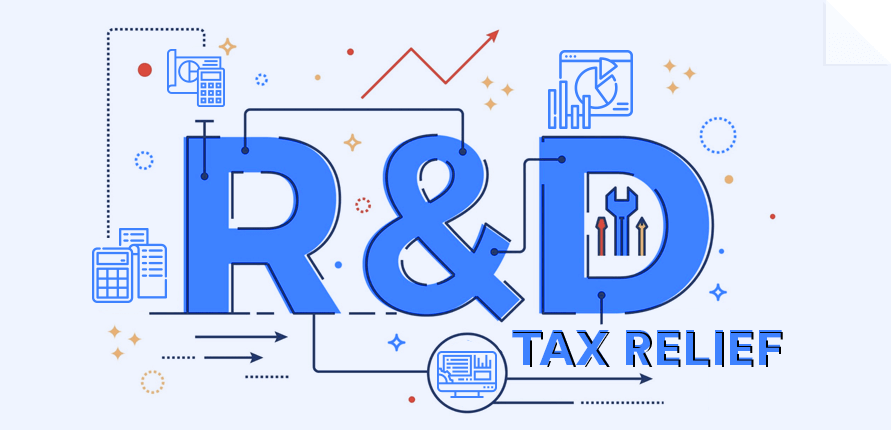
Research and development tax relief is a scheme introduced by HMRC to encourage scientific and technological innovation. This relief is available to corporates and helps in reducing their tax bills significantly. It acts as an incentive to make them more and more involved in technological and scientific innovations. Claiming R&D Tax Relief depends on some specific requirements and so it becomes crucial to understand which expenses can be claimed under the scheme and how can they be claimed correctly.
Projects that count as R&D for the purpose of R&D tax relief
- It is part of a specific project to make an advance in science or technology, except social science like economics or theoretical field like math.
- It must be related to the company’s existing trade or trade activities that the company intends to start based on the results of R&D.
- It may be related to a new process, product, or service or improve on an existing one.
- It is immaterial if the project is successful or not, in either case, R&D tax relief would be available.
R&D tax relief can be claimed only if it can be explained that the R&D project was undertaken:
- seeks an advance in science and technology
- aims to overcome an uncertainty
- tries to overcome this uncertainty
- could not be easily worked out by a professional in the field
Who is eligible to claim R&D tax relief?
- Any company working on an R&D project.
- SMEs and large companies that have been subcontracted to do R&D work by a large company.
Types of R&D tax relief
A) Small or medium-sized enterprise (SME) R&D tax relief for SMEs
It allows SMEs to:
- deduct 130% of their qualifying costs from their annual profit, over and above the normal 100% deduction, thus making it a total 230% deduction.
- if the company is loss-making then claim an R&D tax credit at 14.5% of the surrenderable loss
B) Research and Development Expenditure Credit (RDEC):
Large companies and SMEs, who operate as subcontractors to do R&D work for other large companies, are eligible to avail credit at 13% of the company’s qualifying R&D expenditure. This credit is taxable (see example in the table given below). The R&D tax credit may be used to discharge the tax liability or result in a cash payment depending on whether the company is profitable or loss-making.”
SME for R&D tax relief
The SMEs eligible for R&D tax relief are the SMEs with:
- less than 500 staff
- a turnover of under 100 million euros or a balance sheet total under 86 million euros
Expenses eligible for R&D tax relief
- Consumable items: All consumable items like power, water, etc. used solely for R&D can be eligible for R&D tax relief fully. Apportion the cost of water and electricity bills that can be attributed to R&D. Consumable items include both materials and utilities.
- Software: Fees for software license shall be eligible for relief in full if it is used only for R&D and a reasonable share of this cost shall be eligible where it is used partly for research and development activities.
- Subcontractor cost: Businesses claiming SME for R&D tax relief can claim 65% of the cost of using subcontractor services for R&D. However, those claiming RDEC cannot claim subcontracted expenditure unless it is directly undertaken by a charity, a higher education institute, a scientific research organization, a health service body, an individual, or partnership of individuals.
- Clinical test volunteers: Any payment made to volunteers involved in clinical tests shall be considered a valid R&D expenditure. This type of cost is prevalent in R&D projects of pharmaceutical industries.
- Staff cost: This can be divided into two parts. Cost of internal staff and the cost of external staff.
- Cost of internal staff - Salaries, wages, Class 1 NIC, and pension fund contributions of staff directly engaged with R&D project shall be eligible for the tax relief fully. Salary of any administrative or supportive staff shall be eligible if they directly support the R&D project and shall be proportionately eligible if they work on the R&D project part-time. But clerical or maintenance work that would have been done anyway cannot be claimed as eligible for tax relief.
- Cost of external staff - This relates to staff costs paid to an external agency for staff who is directly and actively engaged in the R&D project. 65% of the payments made to the staff provider can be claimed as expenditure for the purpose of tax relief.
- Costs that cannot be claimed in the R&D tax relief: The cost of production and distribution of goods and services, capital expenditure, cost of land, cost of patents, trademarks, and rents and rates are not eligible to be claimed in R&D tax relief.
Example
The following examples make our understanding of the topic crystal clear. Have a look:
| For SME | For Large Companies (RDEC) | ||||||||||||||||||||||||||||||||||||||||||||||||||||||||||||||||||||||||||||||||||||||
|---|---|---|---|---|---|---|---|---|---|---|---|---|---|---|---|---|---|---|---|---|---|---|---|---|---|---|---|---|---|---|---|---|---|---|---|---|---|---|---|---|---|---|---|---|---|---|---|---|---|---|---|---|---|---|---|---|---|---|---|---|---|---|---|---|---|---|---|---|---|---|---|---|---|---|---|---|---|---|---|---|---|---|---|---|---|---|---|
|
|
Period for which relief can be applied for
The project is assumed to start for the purpose of R&D tax relief when work on resolving the uncertainty begins.
It is assumed to end for the purpose of relief as soon as the uncertainty gets resolved or the work on solving it has been stopped. The period ends when a working prototype to solve the problem has been developed.
After it is put into production, another scientific or technological uncertainty might be discovered which is not any routine fault fixing or design tweaks. In such circumstances, R&D tax relief can again be claimed for another period spent in resolving the said uncertainty.
R&D tax relief can be claimed up to 2 years after the end of the accounting period it relates to.
Advance Assurance
Only SMEs are eligible for Advance Assurance. Any SME planning to engage in the R&D project or has already undertaken it can apply for advanced insurance. Those companies that apply for it are allowed Research and Development tax relief without any further inquiries for the first three accounting periods.
Keeping records
There aren’t any separate records keeping requirements for the purpose of claiming relief. Only at the time of applying for the claim, you need to provide a summary report explaining that the R&D project undertaken satisfies the definition of R&D for tax relief.
Conclusion:
Research and Development often eat away big chunks of money which makes corporates hesitant towards spending on it. The government has incentivised this expenditure so as to invoke the companies to actively engage in in-house R&D so as to increase the country’s R&D base.
But even though so many years have elapsed since the time R&D tax relief was first launched, a large fraction of companies still fail to take benefit of this relief. Large companies generally feel lost in the complications of this claiming relief while the smaller ones fail to reap their benefits due to lack of awareness.












